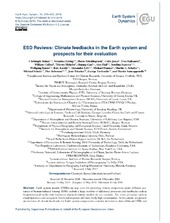| dc.contributor.author | Heinze, Christoph | |
| dc.contributor.author | Eyring, Veronika | |
| dc.contributor.author | Friedlingstein, Pierre | |
| dc.contributor.author | Jones, Colin | |
| dc.contributor.author | Balkanski, Yves | |
| dc.contributor.author | Collins, William | |
| dc.contributor.author | Fichefet, Thierry | |
| dc.contributor.author | Gao, Shuang | |
| dc.contributor.author | Hall, Alex | |
| dc.contributor.author | Ivanova, Detelina | |
| dc.contributor.author | Knorr, Wolfgang | |
| dc.contributor.author | Knutti, Reto | |
| dc.contributor.author | Löw, Alexander | |
| dc.contributor.author | Ponater, Michael | |
| dc.contributor.author | Schultz, Martin G. | |
| dc.contributor.author | Schulz, Michael | |
| dc.contributor.author | Siebesma, Pier | |
| dc.contributor.author | Teixeira, Joao | |
| dc.contributor.author | Tselioudis, George | |
| dc.contributor.author | Vancoppenolle, Martin | |
| dc.date.accessioned | 2020-08-05T12:10:03Z | |
| dc.date.available | 2020-08-05T12:10:03Z | |
| dc.date.issued | 2019 | |
| dc.Published | Heinze C, Eyring V, Friedlingstein P, Jones, Balkanski Y, Collins, Fichefet T, Gao S, Hall A, Ivanova D, Knorr, Knutti R, Löw, Ponater M, Schultz MG, Schulz M, Siebesma, Teixeira, Tselioudis, Vancoppenolle M. ESD Reviews: Climate feedbacks in the Earth system and prospects for their evaluation. Earth System Dynamics. 2019;10(3):379-452 | eng |
| dc.identifier.issn | 2190-4987 | en_US |
| dc.identifier.issn | 2190-4979 | en_US |
| dc.identifier.uri | https://hdl.handle.net/1956/23464 | |
| dc.description.abstract | Earth system models (ESMs) are key tools for providing climate projections under different scenarios of human-induced forcing. ESMs include a large number of additional processes and feedbacks such as biogeochemical cycles that traditional physical climate models do not consider. Yet, some processes such as cloud dynamics and ecosystem functional response still have fairly high uncertainties. In this article, we present an overview of climate feedbacks for Earth system components currently included in state-of-the-art ESMs and discuss the challenges to evaluate and quantify them. Uncertainties in feedback quantification arise from the interdependencies of biogeochemical matter fluxes and physical properties, the spatial and temporal heterogeneity of processes, and the lack of long-term continuous observational data to constrain them. We present an outlook for promising approaches that can help to quantify and to constrain the large number of feedbacks in ESMs in the future. The target group for this article includes generalists with a background in natural sciences and an interest in climate change as well as experts working in interdisciplinary climate research (researchers, lecturers, and students). This study updates and significantly expands upon the last comprehensive overview of climate feedbacks in ESMs, which was produced 15 years ago (NRC, 2003). | en_US |
| dc.language.iso | eng | eng |
| dc.publisher | Copernicus | en_US |
| dc.rights | Attribution CC BY | eng |
| dc.rights.uri | http://creativecommons.org/licenses/by/4.0/ | eng |
| dc.title | ESD Reviews: Climate feedbacks in the Earth system and prospects for their evaluation | en_US |
| dc.type | Peer reviewed | |
| dc.type | Journal article | |
| dc.date.updated | 2020-01-14T13:53:57Z | |
| dc.description.version | publishedVersion | en_US |
| dc.rights.holder | Copyright 2019 The Authors | en_US |
| dc.identifier.doi | https://doi.org/10.5194/esd-10-379-2019 | |
| dc.identifier.cristin | 1711149 | |
| dc.source.journal | Earth System Dynamics | |
| dc.relation.project | Norges forskningsråd: 295046 | |
| dc.relation.project | Norges forskningsråd: 229771 | |
| dc.relation.project | EC/H2020: 641816 | |
| dc.relation.project | EC/FP7: 312979 | |

